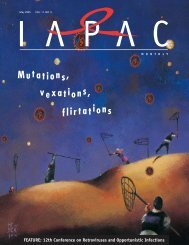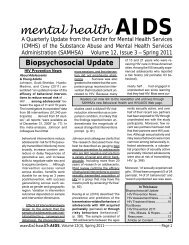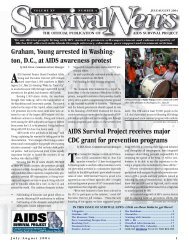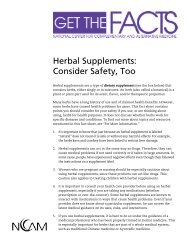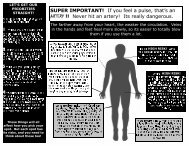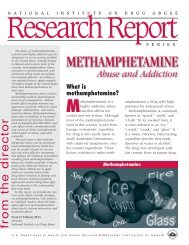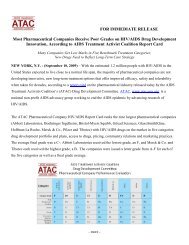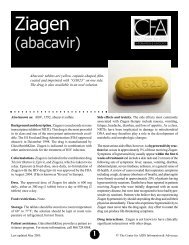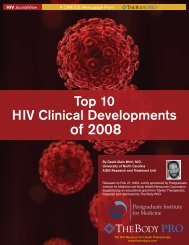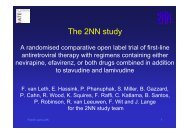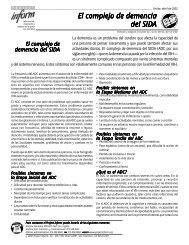Hepatitis C: New Treatments in the Pipeline - CD8 T cells - The Body
Hepatitis C: New Treatments in the Pipeline - CD8 T cells - The Body
Hepatitis C: New Treatments in the Pipeline - CD8 T cells - The Body
Create successful ePaper yourself
Turn your PDF publications into a flip-book with our unique Google optimized e-Paper software.
Oral Antivirals: HCV Protease and Polymerase Inhibitors<br />
<strong>The</strong> NS3-4A ser<strong>in</strong>e protease enzyme and <strong>the</strong> NS5B RNA-dependent RNA polymerase enzyme<br />
are primary targets for oral antiviral agents, s<strong>in</strong>ce both enzymes are essential for HCV<br />
replication. Unfortunately, HCV’s high replication rate—billions of copies per day—leads to<br />
drug resistance. In fact, mutations <strong>in</strong> HCV’s protease and polymerase doma<strong>in</strong>s have already<br />
been characterized, both <strong>in</strong> vitro and <strong>in</strong> vivo (Le Pogam 2006; Zhou 2008).<br />
<strong>The</strong> consequences of acquir<strong>in</strong>g HCV drug resistance are currently unknown; it may be<br />
a transient phenomenon s<strong>in</strong>ce HCV does not <strong>in</strong>tegrate <strong>in</strong>to <strong>the</strong> host cell’s genome. But<br />
it is possible that mutations may confer resistance to an agent—or an entire class of<br />
agents. Drug-resistant HCV may be less fit, but a lower replication capacity will be a scant<br />
consolation for people who have acquired a treatment-resistant virus (Mo 2005; Zhou 2007).<br />
Studies of people who have developed resistance to HCV antivirals should be performed <strong>in</strong><br />
order to fully understand <strong>the</strong> cl<strong>in</strong>ical implications of HCV drug resistance.<br />
As with HIV, hepatitis C treatment requires a comb<strong>in</strong>ation of drugs that target different steps<br />
<strong>in</strong> <strong>the</strong> replication cycle. Sponsors will need to collaborate on multi-agent trials to identify and<br />
optimize treatment strategies. Unfortunately, we must wait until <strong>the</strong>re are enough drugs at<br />
similar stages of development, while push<strong>in</strong>g to facilitate <strong>the</strong>se studies through dialogues with<br />
<strong>in</strong>dustry, researchers, and regulators.<br />
HCV Protease Inhibitors<br />
BILN-2061, an HCV protease <strong>in</strong>hibitor from Boehr<strong>in</strong>ger Ingleheim, was <strong>the</strong> first of its class.<br />
Although BILN-2061 was discont<strong>in</strong>ued due to cardiotoxicity <strong>in</strong> animals, proof of concept was<br />
established (Lamarre 2003). S<strong>in</strong>ce <strong>the</strong>n, <strong>the</strong>re have been high hopes for HCV protease <strong>in</strong>hibitors,<br />
and several are <strong>in</strong> cl<strong>in</strong>ical development. So far, all have been studied <strong>in</strong> people with HCV<br />
genotype 1. Telaprevir, an HCV protease <strong>in</strong>hibitor be<strong>in</strong>g co-developed by Vertex and Tibotec, is<br />
also be<strong>in</strong>g studied <strong>in</strong> people with genotypes 2, 3, and 4 <strong>in</strong> trials outside of <strong>the</strong> U.S.<br />
HCV Protease Inhibitors (oral)<br />
Product Manufacturer Status<br />
BI 12202* Boehr<strong>in</strong>ger Ingleheim Phase I<br />
Boceprevir (SCH 503034) Scher<strong>in</strong>g Plough Phase II<br />
ITMN-191 (R7227) Intermune/Roche Phase Ib<br />
MK-7009 Merck/Isis Phase Ib<br />
Telaprevir (VX-950) Vertex Phase III<br />
TMC 435350 Medivir/Tibotec Phase II<br />
VX-500 Vertex Phase Ia<br />
* Information not confirmed by sponsor<br />
15



